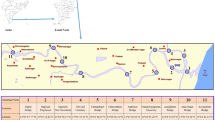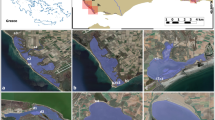Abstract
The concentrations of metals were determined in the water and bottom sediments of both the Urup and Kuban Rivers near tailings sites in the North Caucasus region of southern Russia. The average concentrations in the Urup followed the order Fe > Mn > Pb > Cu > Zn > Cd > Ni > Co, while in the Kuban, the order was Fe > Pb > Zn > Ni > Mn > Cd, with copper and cobalt not detected. The levels of Zn, Cu, Pb, Cd, and Ni were above Russia’s maximum permissible concentration in both rivers. The water pollution index (WPI) values in Urup ranged from 12.97 to 28.17, indicating that the river is extremely polluted (Class VII), while the WPI value for Kuban ranged from 2.34 to 4.33 downstream of the tailings site, which corresponds to Class IV (contaminated). Calculating the coefficient of accumulation in sediments (CAS) revealed that in Urup, the CAS values for Ni and Cu were 3046 and 11638, respectively, which indicates an emergency environmental situation, while for Co, Fe, and Mn, the situation is high level chronic pollution (CAS > 104). The Kuban CAS values of Fe and Mn were also > 104, again highly and chronically polluted. Most of the metals in both rivers are bound to the sediments, with minimal mobility. The potential ecological risk is moderate to considerable in Urup, and low in the Kuban River.
Zusammenfassung
In der Region Nordkaukasus in Südrussland wurden im Wasser und in den Bodensedimenten der Flüsse Urup und Kuban in der Nähe von Tailings die Konzentrationen von Metallen bestimmt. Im Urup folgten die durchschnittlichen Konzentrationen der Reihenfolge Fe > Mn > Pb > Cu > Zn > Cd > Ni > Co, während im Kuban die Reihenfolge Fe > Pb > Zn > Ni > Mn > Cd lautete und Kupfer und Kobalt nicht nachgewiesen wurden. Die Konzentrationen von Zn, Cu, Pb, Cd und Ni lagen in beiden Flüssen über der in Russland jeweils maximal zulässigen Konzentration. Die Werte des Wasserverschmutzungsindex (WPI) für den Urup reichten von 12,97 bis 28,17, was darauf hinweist, dass der Fluss extrem belastet ist (Klasse VII), während der WPI-Wert für den Kuban stromabwärts der Tailings von 2,34 bis 4,33 reichte (Klasse IV, kontaminiert). Die Berechnung des Sedimentakkumulations-Koeffizienten (CAS) ergab, dass für den Urup die CAS-Werte für Ni und Cu 3.046 bzw. 11.638 betrugen, was auf eine Umweltkatastrophe hinweist, währenddessen die CAS-Werte > 104 für Co, Fe und Mn einen hohen Grad chronischer Verschmutzung anzeigen. Für den Kuban waren die CAS-Werte von Fe und Mn ebenfalls > 104, was wiederum eine hohe chronische Verschmutzung bedeutet. In beiden Flüssen sind die meisten Metalle mit minimaler Mobilität an die Sedimente gebunden. Das potentielle ökologische Risiko ist im Urup-Fluss mäßig bis beträchtlich und im Kuban-Fluss niedrig
Resumen
Las concentraciones de metales se determinaron en el agua y los sedimentos del fondo de los ríos Urup y Kuban cerca de los sitios de relaves en la región del Cáucaso Norte del sur de Rusia. Las concentraciones promedio en el Urup siguieron el orden Fe> Mn> Pb> Cu> Zn> Cd> Ni> Co, mientras que en el Kuban el orden fue Fe> Pb> Zn> Ni> Mn> Cd, con cobre y cobalto no detectado. Los niveles de Zn, Cu, Pb, Cd y Ni estuvieron por encima de la concentración máxima permitida de Rusia en ambos ríos. Los valores del índice de contaminación del agua (IPM) en Urup variaron de 12,97 a 28,17, lo que indica que el río está extremadamente contaminado (Clase VII) mientras que el valor del IPM para Kuban varió de 2,34 a 4,33 aguas abajo del sitio de colas, que corresponde a Clase IV (contaminado). El cálculo del coeficiente de acumulación en sedimentos (CAS) reveló que en Urup, los valores de CAS para Ni y Cu fueron 3046 y 11638, respectivamente, lo que indica una situación ambiental de emergencia, mientras que para Co, Fe y Mn, la situación es de alto nivel contaminación crónica (CAS> 104). Los valores CAS de Kuban de Fe y Mn también fueron > 104, nuevamente muy contaminados crónicamente. La mayoría de los metales en ambos ríos están ligados a los sedimentos, con una movilidad mínima. El riesgo ecológico potencial es de moderado a considerable en Urup y bajo en el río Kuban.
摘要
研究了俄罗斯南部北高加索地区尾矿附近Urup河和Kuban河的河水与河流沉积物金属浓度。Urup河金属离子浓度顺序为Fe>Mn>Pb>Cu>Zn>Cd>Ni>Co;Kuban河内金属离子浓度顺序为Fe>Pb>Zn>Ni>Mn>Cd,未检测出Cu和Co。Zn、Cu、Pb、Cd和Ni浓度已经超过两条河的最大允许浓度。Urup河水污染指数为(WPI) 12.97~28.17,表明河水已被严重污染(VII类);Kuban河水在尾矿下游的污染指数(WPI)为2.34~4.33,相当于IV类污染。Urup河的Ni和Cu沉积物累积系数(CAS)已高达3046和11638,环境形势严峻,Co、Fe和Mn呈现高水平慢性污染(CAS>104)。Kuban河的Fe和Mn沉积累积系数(CAS)值也大于104,处于高水平慢性污染状态。两条河中金属沉淀特征明显,迁移程度较小。Urup生态风险中等~严重,Kuban河流生态风险较低。





Similar content being viewed by others
References
Alborov ID (2009) The North Caucasus highland areas: ecology impacts of the mining of different metals. Sustain Dev Mt Territories 1:44–48 (In Russian)
Alimpieva EV (2014) Eco-chemical characteristics of the Greater Caucuses landscape. PhD DISS, Herzen State Pedagogical Univ of Russia, Saint Petersburg (In Russian)
Bezuglova OS, Gorbov SN, Svetlana A, Tischenko SA, Aleksikova AS, Tagiverdiev SS, Sherstnev AK, Dubinina MN (2016) Accumulation and migration of heavy metals in soils of the Rostov region, south of Russia. J Soil Sedim 16:1203–1213
Bogush AA, Lazareva EV (2011) Behavior of heavy metals in sulfide mine tailings and bottom sediment (Salair, Kemerovo region, Russia). Environ Earth Sci 64:1293–1302
Chaikov EB, Popova OV (2013) Accumulation of heavy metals in bottom sediments of western region of north Caspian, the south of Russia. Ecol Dev 1:11–15 (In Russian)
Chernova OV, Beketskaya OV (2011) Permissible and background concentrations of pollutants in environmental regulation (heavy metals and other chemical elements). Eurasian Soil Sci 44:1008–1017
Diyachenko VV, Malykhin YA, Diyachenko LG (2014) The problems of the North Caucasus landscape’s pollution and population’s health. J Environ Prot 5:81–86
Evanko CR, Dzombak DA (1997) Remediation of metals-contaminated soils and groundwater, Tech Report-97-01. GWRTAC, Pittsburgh
Fangjian X, Zhaoqing L, Yingchang C, Longwei Q, Jianwei F, Feng X, Xu T (2017) Assessment of heavy metal contamination in urban river sediments in the Jiaozhou Bay catchment, Qingdao, China. Catena 150:9–16
GOST 17.1.3.13-86 (2013) Protection of the hydrosphere: general requirements for sampling sediments of water bodies for analysis to detect pollutants. Russian Standard for the Protection of Surface Water Bodies
Hakanson L (1980) An ecological risk index aquatic pollution control. A sedimentological approach. Water Res 14:975–1001
Ivanov VV (2012) Hydrographic characteristics and pollution level of Kuban River. Ecol Bull North Caucuses 8:80–84 (In Russian)
Karbassi AR, Bayati I, Moattar F (2006) Origin and chemical partitioning of heavy metals in riverbed sediments. Int J Environ Sci Tech 3:35–42
Kondrat’eva TF, Pivovarova TA, Bulaev AG, Melamud VS, Muravyov MI, Usoltsev AV, Vasil’ev EA (2012) Percolation bioleaching of copper and zinc and gold recovery from flotation tailings of the sulfide complex ores of the Ural region, Russia. Hydrometallurgy 111–112:82–86
Litvintsev VS (2015) Rational development of noble metal placer mining waste in the east of Russia. J Min Sci 51:118–123
Ministry of Natural Resources of the Russian Federation (1992) Criteria for assessing the ecological situation in the territories for identifying zones of emergency ecological situation and zones of ecological disaster. http://www.priroda.ru/lib/detail.php?ID=5179. Accessed 7 Apr 2017
Nasrabadi T, Bidhendi GN, Karbassi A, Merdadi N (2010) Partitioning of metals in sediments of the Haraz River (southern Caspian Sea basin). Environ Earth Sci 59:1111–1117
Nguyen VK, Lee JU (2015) A comparison of microbial leaching and chemical leaching of arsenic and heavy metals from mine tailings. Biotechnol Bioproc E 20:91–99
Nikanorov AM, Khourzhaya TA (2012) Tendencies of long-term changes in water quality of water bodies in the south of Russia. Geogr Nat Resour 33:125–130
Nikitina TA, Belan EV (2010) The water ecosystems in the Kuban River basin (middle and lower flow). Eur J Nat Hist 5:59–59
Qingjie G, Jun D, Yunchuan X, Qingfei W, Liqiang Y (2008) Calculating pollution indices by heavy metals in ecological geochemistry assessment and a case study in parks of Beijing. J China Univ Geosci 19:230–241
Rigina O (2001) Environmental impact assessment of the mining and concentration activities in the Kola peninsula, Russia by multidate remote sensing. Environ Monit Assess 75:11–31
Timofeev IV, Kosheleva NE, Kasimov NS, Gunin PD, Sandag EA (2016) State of the environment of urban and mining areas in the Selenga transboundary river basin (Mongolia, Russia). Environ Earth Sci 75:1–20
Vodyanitski YN (2013) Contamination of soils with heavy metals and metalloids and its ecological hazard (analytic review). Degrad Rehab Cons Soils 46:793–801
Wuana RA, Okieimen FE (2011) Heavy metals in contaminated soils: a review of sources, chemistry, risks and best available strategies for remediation. ISRN Ecol. https://doi.org/10.5402/2011/402647
Yurkevich NV, Saeva OP, Karin YG (2015) Geochemical anomalies in two sulfide-bearing waste disposal areas: Fe, Cu, Zn, Cd, Pb, and As in contaminated waters and snow, Kemerovo and Chelyabinsk regions, Russia. Toxicol Environ Chem 97:76–89
Zhu X, Ji H, Chen Y, Qiao M, Lei TT (2013) Assessment and sources of heavy metals in surface sediments of Miyun Reservoir, Beijing. Environ Monit Assess 185:6049–6062
Zvereva VP, Krupskayac LT, Malyuke YN (2013) The influence of Karamkenskoe deposit tailing dump on the region hydrosphere and the dump recultivation (Magadan region) Russian. J Gen Chem 83:2694–2700
Author information
Authors and Affiliations
Corresponding author
Rights and permissions
About this article
Cite this article
Abu Qdais, H., Begday, I.V., Katorgin, I.Y. et al. Assessment of Metals Pollution from Tailing Sites in the North Caucuses Region, Russia. Mine Water Environ 37, 815–824 (2018). https://doi.org/10.1007/s10230-018-0545-x
Received:
Accepted:
Published:
Issue Date:
DOI: https://doi.org/10.1007/s10230-018-0545-x




